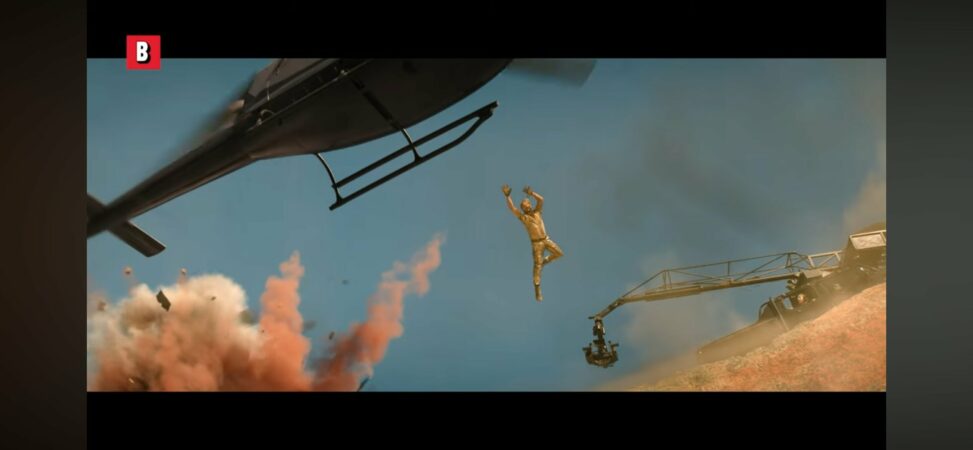The Fall Guy is an action comedy film that debuted in May of 2024. With stereotypical white male heartthrob Ryan Gosling playing the hero, it is no surprise this film brought in $27,747,035 across 4,002 theaters . Like most action films, Gosling played a man trying to win back the love of his life while obstacles stood in the way. While it may have a different storyline than some action movies, its use of camera angles, editing, and typical man saving women hero arc reinstates why it falls under the action genre.
The Fall Guy is an action comedy. This means unlike traditional action movies, the violence is interrupted by unserious scenes and shenanigans. A study from 2001 found that Violent Action Comedies typically result in lower aggressive arousal/ negative affective arousal than typical violent action films. This unique combination of fights and jokes allows for a more enjoyable viewing experience. This film uses multiple media strategies to achieve its action movie intensity while ensuring Its happy ending leaves the audience feeling as though the violence was all worth it.
Ryan Gosling’s character, Colt Seavers, demonstrates the ideal male physique. With low angle camera shots on his genital area, slow upward pans of his entire half naked body, his body is treated as part of his heroism. It is no secret that what we see in the media shapes the way we think of ourselves, but this ‘hero body type’ reinforces the association between muscularity in men and characteristics such as physical attractiveness, desirability, self-worth, and success . In the opening scene, the film pans from his boots, all the way up his body as he’s walking. His large feet and how long it takes to get up his body shows us just how large and in charge he is. These angles create suspense as we await what we can only assume is a gigantic, muscular man, based on the clues given through editing and camera panning. This can have negative effects on male self confidence and body image, as only one body type receives affection on screen.
In 2024, The percentage of major female characters rose by a single percentage point, from 38% in 2023 to 39% in 2024. This film contributed to the 1% having Emily Blunt play the female lead and love interest, Jody Moreno. This is common in films, as women are not central to the narrative except as motivation for the hero’s mission. This can be identified using Mes en Scene or visual storytelling. Often, Moreno appears off center in shots. More importantly, we see Seavers point of view, how she looks to him, and over the shoulder shots of her. The focus is on how he sees her. Additionally, in many shots, Seavers is closer to the viewer than she is, reinstating the importance of him. This type of camera work reinstates a patriarchal view, which can have damaging effects in real life.
With there being many explosions and choreographed fight scenes, it was difficult to decide which was most significant. The final action scene, involving a high speed car chase, gun fire, and a helicopter fight, was the most captivating. This scene using multiple short takes edited together to create a montage of explosions and chaos. The shot where Seavers is between the car and the helicopter is what I have chosen to highlight. With an upward angle looking from the point of view of his love interest, the tone and colour obscured by dust and dreary lighting creates tension. The sound of helicopter blades chopping through the air cuts off their conversation and creates a moment of stillness. Additionally, this angle shows us how high up he is, reinforcing the danger of falling. In this one scene, I could identify 6 different edits. While the number is low, the edits were effective. The use of a slow motion pan and zoom in on the bar he is trying to grab also creates uncertainty. The high speed action being slowed down makes the moment stretch, capturing the viewers attention.
An important thing to note in this scene is that while there is a car chase, Seavers jumps off a camera arm attached to a car and onto a helicopter. While reckless driving is shown, the consequences are not. Showing heroes as risky drivers might provide attractive role models. Promoting violent driving can influence new drivers to think this is normal, seeing as there is no consequence shown on screen. Additionally, a study in 2005 found there is evidence proving violent imagery has short-term effects on arousal, thoughts, and emotions, increasing the likelihood of aggressive or fearful behaviour.
Showing violence like this in the media continues to have negative effects. However, this film uses comedy to disguise that. Using cheeky dialog during car chases and one liners in fight scenes, it dilutes the aggression found in typical action movies. As a result, viewers leave the theatre feeling positive despite watching a violent film. This is the feeling that keeps viewers coming back for more action, every time.
References
Beullens, Kathleen, Keith Roe, and Van Den Bulck. “THE PORTRAYAL OF RISK-TAKING IN TRAFFIC: A CONTENT ANALYSIS OF POPULAR ACTION MOVIES.” Journal of Communications Research 2, no. 1 (2011). https://www.researchgate.net/profile/Keith-Roe/publication/258960223_The_portrayal_of_risk-taking_in_traffic_A_content_analysis_of_popular_action_movies/links/54cb8bef0cf2598f71175f76/The-portrayal-of-risk-taking-in-traffic-A-content-analysis-of-popular-action-movies.pdf.
Brown, Jeffrey A. “Gender and the Action Heroine: Hardbodies and the ‘Point of No Return.’” Cinema Journal 35, no. 3 (1996): 52. https://doi.org/10.2307/1225765.
Browne, K, and C Hamilton Giachritsis. “The Influence of Violent Media on Children and Adolescents: A Public-health Approach.” The Lancet 365, no. 9460 (February 25, 2005): 702–10. https://doi.org/10.1016/s0140-6736(05)70938-7.
Heil, Susan Kay Romoser. Does Humor Mediate the Effects of Film Violence?: Affective Consequences of Viewing the Violent Action Comedy, 2001.
Lauzen, Martha. “It’s a Man’s (Celluloid) World: Portrayals Of Female Characters In the Top Grossing U.S. Films Of 2024.” 23rd ed., 2025. https://womenintvfilm.sdsu.edu/wp-content/uploads/2025/02/2024-Its-a-Mans-World-Report.pdf.
Morrison, Todd G., and Marie Halton. “Buff, Tough, and Rough: Representations of Muscularity in Action Motion Pictures.” The Journal of Men S Studies 17, no. 1 (February 28, 2009): 57–74. https://doi.org/10.3149/jms.1701.57.
Box Office Mojo. “The Fall Guy – Box Office Mojo,” n.d. https://www.boxofficemojo.com/release/rl752190209/?ref_=bo_gr_su.


Karma Marzouk
In this analysis of the action sequence in The Fall Guy, Victoria talks about how action comedies allow for more enjoyable audience experiences, than a typical action film made up of mostly violence. While The Fall Guy still does contain violence throughout the film, the comedic relief throughout helps soften the blow. She also goes into detail about the male vs. female character’s in the film, which was very interesting to read and helped me understand the genre of comedy this film is striving for.
Victoria chose to analyze the final action scene, as it holds the most intense and captivating moments throughout the film. she explains what is happening in the scene, and has someone who has not seen this film before, she did a good job at helping me visualize these significant moments in the way that she describes how shots are taken, including angles and edits, tone and colour (describing the atmosphere the scene), as well as audio and what you can hear in the scene.
One thing that Victoria could have done differently was add a short and brief summary on what the film is about, although it is not part of the assignment, it could give people like me who have never seen the film a rough idea on some of the big ideas in the analysis.
Victoria hit all the marks in the analysis and did an overall great job, and made this film seem intriguing enough for me to want to watch!